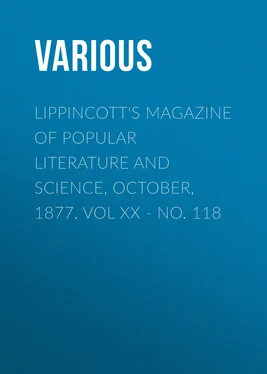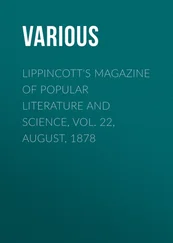Various - Lippincott's Magazine of Popular Literature and Science, October, 1877. Vol XX - No. 118
Здесь есть возможность читать онлайн «Various - Lippincott's Magazine of Popular Literature and Science, October, 1877. Vol XX - No. 118» — ознакомительный отрывок электронной книги совершенно бесплатно, а после прочтения отрывка купить полную версию. В некоторых случаях можно слушать аудио, скачать через торрент в формате fb2 и присутствует краткое содержание. Издательство: Иностранный паблик, Жанр: foreign_antique, periodic, foreign_edu, на английском языке. Описание произведения, (предисловие) а так же отзывы посетителей доступны на портале библиотеки ЛибКат.
- Название:Lippincott's Magazine of Popular Literature and Science, October, 1877. Vol XX - No. 118
- Автор:
- Издательство:Иностранный паблик
- Жанр:
- Год:неизвестен
- ISBN:нет данных
- Рейтинг книги:4 / 5. Голосов: 1
-
Избранное:Добавить в избранное
- Отзывы:
-
Ваша оценка:
- 80
- 1
- 2
- 3
- 4
- 5
Lippincott's Magazine of Popular Literature and Science, October, 1877. Vol XX - No. 118: краткое содержание, описание и аннотация
Предлагаем к чтению аннотацию, описание, краткое содержание или предисловие (зависит от того, что написал сам автор книги «Lippincott's Magazine of Popular Literature and Science, October, 1877. Vol XX - No. 118»). Если вы не нашли необходимую информацию о книге — напишите в комментариях, мы постараемся отыскать её.
Lippincott's Magazine of Popular Literature and Science, October, 1877. Vol XX - No. 118 — читать онлайн ознакомительный отрывок
Ниже представлен текст книги, разбитый по страницам. Система сохранения места последней прочитанной страницы, позволяет с удобством читать онлайн бесплатно книгу «Lippincott's Magazine of Popular Literature and Science, October, 1877. Vol XX - No. 118», без необходимости каждый раз заново искать на чём Вы остановились. Поставьте закладку, и сможете в любой момент перейти на страницу, на которой закончили чтение.
Интервал:
Закладка:
Farndon Bridge and Wrexham Church (the latter looks like a small cathedral to the unpractised eye) are the last Welsh points of attraction before the Dee becomes quite an English river. Malpas ( mauvais pas = "bad step"), on the English bank, is significantly so-called from its situation as a border town: the rector, too, might consider it not ill named, as regards the odd partition of the church tithes, which has been in force from time immemorial, and has given rise to an explanatory legend concerning a travelling king whom the resident curate wisely entertained in the absence of the rector, receiving for his guerdon a promise of an equal share in the income, not only for himself, but for all future curates. In the upper rectory (the lower is the curate's house) was born Bishop Heber in 1783, and in the early years of this century, before missionary meetings were as common as they are now, the young clergyman wrote on the spur of the moment, with only one word corrected, the well-known hymn, "From Greenland's Icy Mountains." A missionary sermon was announced for Sunday at Wrexham, the vicarage of Heber's father-in-law, Shirley, and the want of a suitable hymn was felt. He was asked on Saturday to write one, and did so, seated at a window of the old vicarage-house. It was printed that evening, and sung the next day in Wrexham Church. The original manuscript is in a collection at Liverpool, and the printer who set up the type when a boy was still living at Wrexham within the last twenty years.
The river now makes a turn, sweeping along into English ground and making almost a natural moat round Chester, the great Roman camp whose form and intersecting streets still bear the stamp of Roman regularity, and whose history long bore traces of the influence of Roman inflexibility mingled with British dash. The view of the city is fine from the Aldford road (or Old Ford, where a Roman pavement is sometimes visible in the bed of the stream), with the cathedral and St. John's towering over the peaks and gables that shoot up above the walls. The mention of the ford brings to mind a famous crossing of the river during the civil wars. It was just before the battle of Rowton Moor, which Charles I. watched from the tower that now bears his name; and Sir Marmaduke Langdale, one of his leal soldiers, wishing to send the king notice of his having crossed the Dee at Farndon Bridge and pressing on the Parliamentarians, bade Colonel Shakerley convey the message as speedily as possible. The latter, to avoid the long circuit by the bridge, galloped to the Dee, took a wooden tub used for slaughtering swine, employed "a batting-staff, used for batting of coarse linen," as an oar, put his servant in the tub, his horse swimming by him, and once across left the tub in charge of the man while he rode to the king, delivered his message and returned to cross over the same way.
Eaton and Wynnestay are the grandest of the Dee country-seats, though not the most interesting as to architecture. The former, like many Italian houses, has its park open to the public, and is an exception to the jealously-guarded places in most parts of England, but its avenues, rather formal though very magnificent, are approached by lodges. The Wrexham avenue leads to a farmhouse called Belgrave, and here is the christening-point of the new, fashionable London of society, of novelists and of contractors. Another like avenue leads to Pulford, where there is another lodge: a third leads from Grosvenor Bridge to the deer-park, and a fourth to the village of Aldford. The hall is an immense pile, strikingly like, at first glance, the Houses of Parliament, with the Victoria Tower (this in the hall is one hundred and seventy feet high, and built above the chapel), and the style is sixteenth-century French, florid and costly. The plan is perhaps unique in England, and comfort has been attained, though one would hardly believe it, such size seeming to swamp everything except show. The description of the house, as given by a visitor there, reads like that of a palace: "The hall is an octagonal room in the centre of the house about seventy-five feet in length and from thirty to forty broad: on each side, at the end farthest from the entrance, are two doors leading into anterooms—one the ante-drawing-room, and the other the ante-dining-room; each is lighted by three large windows, and is thirty-three feet in length: they are fine rooms in themselves, and well-proportioned. From these lead the drawing-room and the dining-room respectively, both exceedingly grand rooms, ingenious in design and shape, each with two oriel windows and lighted by three others and a large bay window: this suite completes the east side. The south is occupied by the end of the drawing-room and a vast library—all en suite . The library is lighted by four bay windows, three flat ones and a fine alcove, and the rest of the main building to the west is made up of billiard- and smoking-rooms, waiting-hall, groom-of-chambers' sitting- and bed-rooms, and a carpet-room, besides the necessary staircases. This completes the main building, and a corridor leads to the kitchen and cook's offices: this corridor, which passes over the upper part of the kitchen, branches off into two parts—one leading to an excellently-planned mansion for the family and the private secretary, and another leading to the stables, which are arranged with great skill. The pony stable, the carriage-horse stable, the riding horses, occupy different sides, and through these are arranged, just in the right places, the rooms for livery and saddle grooms and coachmen. The laundry, wash-house, gun-room and game-larder occupy another building, which, however, is easily approached, and the whole building, though it extends seven hundred feet in length, is a perfect model of compactness. Great facilities are given to any one who desires to see it." The mention of a "mansion for the family" shows how the associations of a home are lost in this wilderness of magnificence: indeed, I remember a remark of a person whose husband had three or four country-houses in England and Scotland and a house in London, that "she never felt at home anywhere."
The farms in this neighborhood are mostly small, the average being seventy acres, and some are still smaller, though when one gets down to ten, one is tempted to call them gardens. Grazing and dairy-work are the chief industries. Farther inland, beyond the manufacturing town of Stockport, is a house of the Leghs, an immense building, more imposing than lovely in its exterior, but one of the most individual and pleasant houses in its interior as well as in its human associations. It has been altered at various times, and bears traces, like a corrected map, of each new phase of architecture for several hundred years. The four sides form a huge quadrangle, entered by foreign-looking gateways, and the rooms all open into a wide passage that runs round three sides of the building, and is a museum in itself. Old and new are just enough blended to produce comfort, and the stately, old-English look of the drawing-room, with its dark panelling and tapestry, is a reproach to the pink-and-white, plaster-of-Paris style of too many remodelled houses. Outside there is a garden distinguished by a heavy old wall overrun with creepers, dividing two levels and making a striking object in the landscape; and beyond that, where the country grows bleak and begins to remind one of moors, there are the last survivors of a unique breed of wild cattle, which, like the mastiffs at the house, bear the name of the place. The name of another Cheshire house, formerly belonging to the Stanleys, and now to Mr. Gladstone, is probably familiar to American readers—Hawarden Castle. The present house must trust entirely to associations for its interest, having been built in 1809, before much taste was applied to restore old places, but the old castle in the park dates from the middle of the thirteenth century. The park is not unlike that of Arundel, but the views from the ruin are finer and more varied. The counties of Caernarvon, Denbigh, Flint, Cheshire and Lancashire are spread out around it, and the ruin itself is beautiful and extensive.
Читать дальшеИнтервал:
Закладка:
Похожие книги на «Lippincott's Magazine of Popular Literature and Science, October, 1877. Vol XX - No. 118»
Представляем Вашему вниманию похожие книги на «Lippincott's Magazine of Popular Literature and Science, October, 1877. Vol XX - No. 118» списком для выбора. Мы отобрали схожую по названию и смыслу литературу в надежде предоставить читателям больше вариантов отыскать новые, интересные, ещё непрочитанные произведения.
Обсуждение, отзывы о книге «Lippincott's Magazine of Popular Literature and Science, October, 1877. Vol XX - No. 118» и просто собственные мнения читателей. Оставьте ваши комментарии, напишите, что Вы думаете о произведении, его смысле или главных героях. Укажите что конкретно понравилось, а что нет, и почему Вы так считаете.












